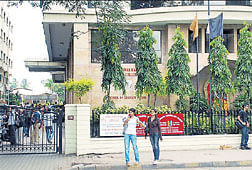
Dropping the option to take an MBBS seat after securing a top rank is quite common these days. But giving it up for a basic sciences degree, most would consider is career suicide.
But that is what Himami Galagali has done. Having secured the fourth rank in the medical CET this year, she ignored the counselling session and gave up the chance to study in the medical college of her choice — all to pursue a degree in science.
What has changed?
Himami is joining the Indian Institute of Science (IISc), which is embarking on a significant experiment to rekindle interest in basic sciences at the undergraduate level. The institute has just launched its four-year bachelor’s in science programme, which differs considerably from the typical three-year course. (It’s a BS degree, not a BSc degree).
The IISc is at the forefront of several approaches that seek to break the barriers in higher education. These experiments are not confined to science alone. Bangalore University is exploring four-year courses in both Commerce and Arts. While BA and BCom honours courses are offered across select colleges, the four-year courses in Arts and Commerce are being introduced for the first time in the country.
BU Vice Chancellor N Prabhu Dev said: “The courses were introduced after seeing the success of their four-year science programmes. For students who wish to pursue their master’s abroad, the four-year course spares them from toiling an extra year abroad.”
Institutions that have been granted academic autonomy by the University Grants Commission (UGC) are also attempting to revive interest in basic degrees — the BA, BCom, and BSc degrees — in smaller ways, within the constraints that they function in.
Of course, these experiments are market driven, but they fill a long-standing need for employers. Dr Easwaran Iyer, who is the Dean (Commerce) at Jain University, said conventional syllabus was neither industry acceptable nor flexible. Being autonomous, Jain University designed syllabi suitable for industry demand. Many students go for paid internships while pursuing their degrees — earn while they learn.
Rupali Sharma, who works at a headhunting firm Headstrong, says over the past few years, there has been a gradual increase in interest among employers for people who have emerged from such courses. “Employers are just not interested in the regular BA or BCom students,” she says. “People who have done courses that fall outside the traditional framework have done much better. For us, it is easier to sell candidates who have done these courses,” she adds.
‘China walls’
For long, the higher education system in the country has erected ‘China walls’ that neatly isolate various branches. For instance, the higher education system has perpetuated the artificial division between professional and general degree education, or the distinction between 'science' degrees and 'engineering' degrees.
Higher education in India is a strictly top-down affair. The University Grants Commission, tasked with policing the non-professional education system, sets the degrees and courses that universities can offer. Universities, in turn, design the syllabus for courses offered by hundreds of undergraduate colleges affiliated to them.
This distinction also extends between professional courses and basic degree courses. The UGC has preferred a 3+2 model for general degree courses; complete a three-year bachelor’s degree, which provides you a foundation, followed by a two-year master’s degree, after which you can enter a profession. In contrast, professional courses, such as an engineering or an MBBS course, will train you so that you can enter a job directly.
This was recognised by the Yashpal Committee formed to reform the higher education system. In its report, the committee wrote: “We were struck by the fact that over the years we have followed policies of fragmenting our educational enterprise into cubicles. We have overlooked that new knowledge and new insights have often originated at the boundaries of disciplines.”
Later on, the committee writes: “We tend to imprison disciplinary studies in opaque walls. This has restricted flights of imagination and limited our creativity. This character of our education has restrained and restricted our young right from the school age and continues that way into college and university stage.”
Hurdles in reform
The Indian education system’s rigid power structure prevents colleges from experimenting significantly. Even institutes outside the purview of the UGC have not been able to move outside the UGC’s shadow. Take the case of the Indian Institutes of Science and Education Research (IISERs). Tasked with reviving basic science education, these institutes were not even able to offer anything different from the UGC’s standard 3+2 model. At best, the IISERs have been able to offer only an integrated master’s programme.
So, it took the heft and prestige of an institute such as the IISc to effect some change. In this particular case, the distinction between science and engineering –– which many like the Yashpal committee deem to be artificial –– is being tackled head-on by the institute.
Of course, providing autonomy without accountability can also go awry, as was demonstrated in the case of deemed universities. Deemed universities were initially set up with the desire to provide complete autonomy to colleges to provide a sort of freedom.
The system soon degenerated into a way for colleges wanting to escape from the bureaucratic stranglehold of the regulatory bodies. Colleges with questionable credentials made their way, and now a case is before the Supreme Court to decide on the fate of many dubious institutions.
